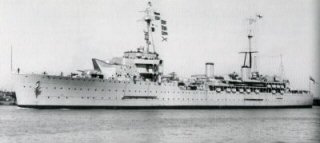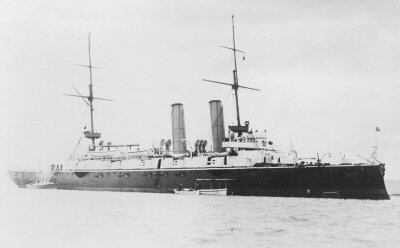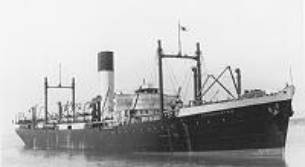|
Letters
Sylvester White, the Chief Petty Officer went down with HMS Boadicea See "Thomas Heron who lost his life in HMS Boadicea" You had an enquiry from Erin Harris about the Boadicea. Please find atttached information to forward to her. The Sylvester referred to was my uncle Sylvester White, the Chief Petty Officer, who went down with the ship. Tom Knott
Thank you for your thoughtfulness, and time, in forwarding this information about HMS Boadicea. I have sent it on to Erin, together with your address. We gain in our knowledge of ship losses such as this one etc, through the personal records held by individuals, such as yourself. This type of history is often hidden away in a shoe box in someone's wardrobe or garage, to be lost to posterity. Hopefully, AHOY may bring it to a wider audience, and for Erin, she has the benefit of you helping her with some further detail of this destroyer in WW2. Best regards,
You are very welcome to publish, the paper was an extract from a rather longer document on the whole of Sylvester's life that I did for my cousins who knew little about their father and his family, we have only recently reconnected. As I just took parts out for you to send for info to the lady who was enquiring, I have slightly amended the first section for the purposes of web use etc, and given it a heading. Also, I have attached my name and mail address if this should be useful. Glad to help! Best wishes, ----------------------------------------------------------------------------------------------------- HMS BOADICEA Sylvester White, my uncle, died on 13 June 1944, in the loss of HMS Boadicea by enemy action off Portland Bill, Dorset, and his rank then was Chief Petty Officer, so the highest ranking of the seamen on board outside the Commissioned Officer class. Whether he might have been given a commission is an open question, one reason why he might not have been is that the Navy by 1940-1944 were short of experienced, educated, and capable men to fill the critical position of senior petty officers on seagoing ships. A good Chief Petty Officer with the respect of the men was rather more valuable than just another junior officer, especially on the guns. Sylvester had joined the Navy in 1927 as soon as he was of age, and before joining the Boadicea in 1940 had served in several ships including HMS Repulse and HMS York as well as a short spell in the submarine service in the Pacific. He was from Liverpool, one of a large family, and close to my parents. His wife, Helen, and children had been with us in Leicester to escape the Blitz in the East End of London. His loss was a great blow to all his family. The Boadicea was involved in Operation Neptune, the Royal Navy part of Operation Overlord, the Normandy Landings of the 6 June 1944, D-Day. On that day she escorted one of the assault convoys over to the landing area, and continued to escort follow-up convoys during the days after to maintain the impetus of the invasion. Successive waves on troops were landed on the days following, critically the armoured formations. There were also men to be brought back to England, those who were injured. On 13 June 1944 Boadicea came under attack by a Ju88 German torpedo bomber. She was struck by two torpedoes, one that hit the forward magazine blowing the ship in half. She sank in three minutes. There were only 12 survivors from 186 men. The action occurred 16 miles south west of Portland Bill. She now lies in 52 metres of water at the co-ordinates 50-25.70 North and 02-49.90 West. Her guns still point towards the sky. HMS Boadicea went down fighting. HMS Boadicea HMS Boadicea was a Beagle Class Destroyer authorised in the 1928 Naval Programme. She was built and engined by Hawthorn, Leslie, & Co. Ltd, Hebburn on Tyne, laid down on the 11 July 1929 and launched on 23 September 1930, being completed on 7 April 1931. The cuts in naval expenditure resulted in her being mothballed for a period until full service began in 1933 her service initially being in home waters.
At the outbreak of war Boadicea was attached to the 19th Destroyer Flotilla based at Dover, her duties being to cover the movement of troopships to France and to cover minelayers carrying out lays. At the end of October 1939 she became part of the East Coast Defence Force based at Harwich. In May 1940 she was taken in for a refit at Chatham, and when operational again went to Le Havre in June in the attempt to evacuate the 51st Highland Division that had been held in reserve in France and then caught and stranded by the suddenness of the collapse of the French forces. Whilst off Le Havre the Boadicea took three direct hits by aircraft bombs and was disabled. She was towed back to Portsmouth for repairs moving to Pembroke at the home base of Chatham for supplies and remanning. It was here that Sylvester joined her and was issued with winter clothing. It was in May 1941 that she was attached to the Depot Ship HMS Hecla and took part in the search in the Atlantic for the German cruisers the Scharnhorst and the Gneisenau. Hecla was a new destroyer depot ship built 1940 and sent to Hvalfiord, Iceland, in 1941. She was torpedoed in 1942 off Africa.
After this Boadicea joined the squadron based on HMS Orlando and went to Greenock, on the Clyde to escort convoys to the mid-Atlantic dispersal line and to rendezvous with convoys for escort to Britain. Orlando was an old armoured cruiser, built in 1888, featured in the Boxer Rebellion in China, and then had a chequered career, ending as a depot ship in the Clyde. In April 1942 Boadicea left Greenock for Iceland and served on the Russian convoys. The treaty signed by Germany and the Soviet Union came to a sudden end in June 1941 with a Blitzkrieg on the Eastern Front for which Stalin was unready. In the flurry of reactions Churchill offered help with supplies and materials to the Soviets, despite Britain’s own desperate situation and the risks of burdens this would place on the Navy with the Germans controlling Norway.
Boadicea joined as an escort for convoy PQ15. Three of the merchant ships were sunk, but despite successive air attacks these were the only losses before its arrival at Kola on 5 May 1942. The returning convoy QP12 returned intact to Reykjavik, and Boadicea returned to Greenock to join the Special Escort Division to escort troopships across the Atlantic. In 1941, Japan, decided to dominate the Pacific and the Far East, for the oil and other materials for its military, and attacked Pearl Harbour in December to neutralise the American forces. Britain, also under attack had declared war, and Germany had allied herself to Japan. Italy joined Germany in 1940 in order to control of the Mediterranean. Germany was forced into the Balkans and North Africa in 1941 to rescue the Italians. Britain and the Soviet Union had invaded Iran to rid it of Germans and secure their oil supplies, installing a 21 year old Shah. Japan’s arrogance had the effect of bringing the industrial might and resources of America into the War, saving Britain, whose financial resources were now at an end, and the Soviet Union. At the beginning of August 1942 after escorting the Dominion Monarch from Halifax to Liverpool, Boadicea went to the Clyde for a refit, additional guns being fitted.
After this Boadicea went as escort for convoy KX2, a preparatory stage for Operation Torch, the landings in French North Africa to follow up Montgomery’s 8th Army campaign after the Battle of El Alamein. She took over screening duties with Force H and while on patrol for anti- submarine work was hit in the shell room by a shell from a French destroyer, but was able to continue with her duties. On 11 November Boadicea was in company with the troopship the Viceroy of India when the former liner was torpedoed and sunk. Boadicea rescued 425 of the survivors and carried them to Gibraltar.
From 12 November her duties involved escorting various convoys, mostly to and from North Russia. In March 1943 she reported damage from ice and returned to the Clyde for repairs. On her return to service she was transferred to the West Africa Command based at Freetown where the depot ship was HMS Philoctetes. This was a former large Blue Funnel Line merchant ship on the China service bought by the Admiralty in 1940 for conversion to a destroyer depot vessel. She was broken up in 1948.
Boadicea remained on the Freetown Station escorting convoys to and from Freetown, Takaradi, Lagos, and Cape Town. In October 1943 she returned to Britain, to the depot ship Orlando, for a long refit until the end of January 1944, when she resumed duties on the convoys to North Russia until May 1944. Then Boadicea moved to Plymouth in readiness for Operation Neptune and the Normandy landings on 6th June, and was lost one week later on Tuesday, 13th June. Tom Knott |






